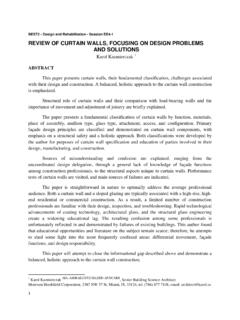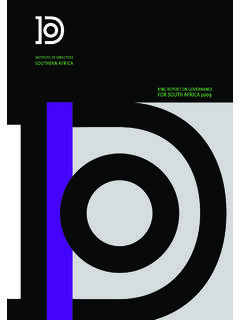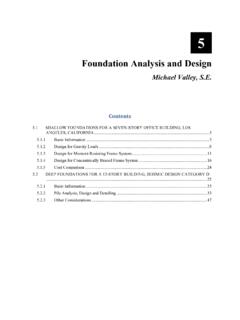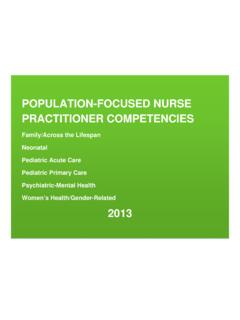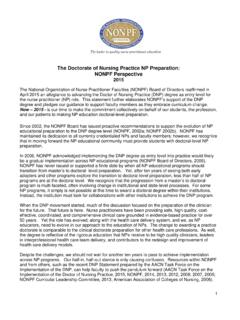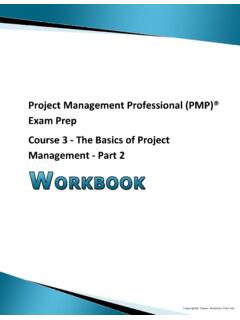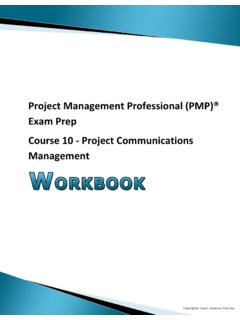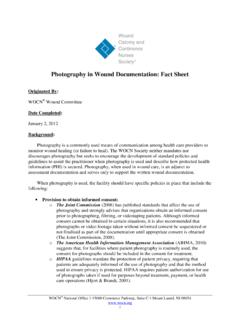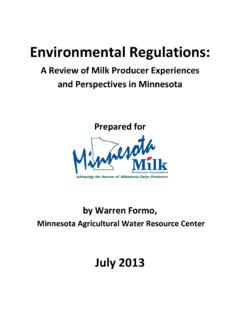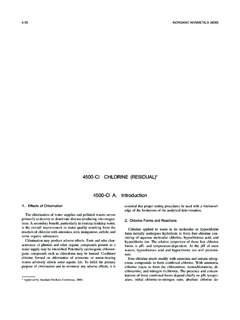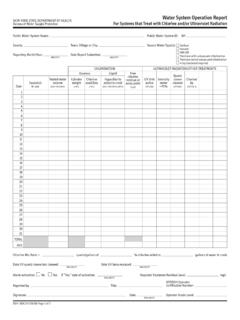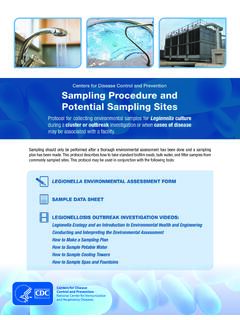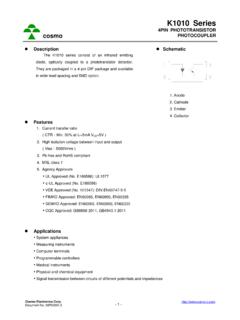Transcription of free chlorine presentation.ppt
1 1 Breakpoint you Really Have a Free chlorine residual ?ChloraminationNitrificationDisi nfection ByproductsBob Spon, chemistSpon Water Consulting2 Water Quality Problems in Distribution Systems 160 responses to AWWA survey indicates % of annual reported problems: 44% Taste & Odor 43% Color & Turbidity 5% High Heterotrophic Plate Count 5% DBP s, coliforms, corrosion, misc. 3% Loss of disinfection residual Do you have a free Cl2residual?3 What is a free residual ? chlorine in pure H2O = HOCl + OCl- HOCl = Hypochlorous Acid OCl-= Hypochlorite Ion Free chlorine residual = HOCl / OCl- Free available chlorine is very reactive total chlorine Free = Combined Minimum system chlorine residuals: IL EPA: free / mg/L total IA DNR: mg/L free / mg/L total FL DEP: mg/L free / mg/L totalFree Available chlorine Residuals(HOCl H++ OCl-) chlorine DosageChlorine ResidualBreakpoint Chlorination CurveBreakpoint dip Peak caused when chlorine combines with ammonia & organicsCombined chlorine residual (THM & HAA)4 What is chlorine Breakpoint?
2 The initial point where free available chlorine residual is present / detected Breakpoint residual occurs after the chlorine dosage rate exceeds the demand created by reducing agents, ammonia, and organics curve-shape is determined by contact time, temp, chlorine and ammonia concentration, pH, and water qualityChlorine DosageChlorine ResidualBreakpoint Chlorination Curve (No/Low ammonia/organics present)Free Available & Detectable chlorine Residuals(HOCl H++ OCl-)Initial chlorine Demand Caused by Reducing AgentsNO residual Until Demand is Exceeded5 Initial chlorine Demand-Reducing Agents Cl2dosage - Demand = residual 1 mg/- mg/L = mg/L Initial demand = Reducing Agent mg/L (Fe+2, Mn+2, H2S, NO2-) (Fe+2, H2S, NO2-) may reappear in plant/system If Dosage </= Demand then 0 residual If Dosage > Demand then free residual exists Reducing Agents donate / lose electrons (consume oxidizing agents such as chlorine )Reducing AgentReactions with chlorine (Demand & Destroy chlorine residual )
3 NO2-+ HOCl NO3-+ H++ Cl-H2S+ Cl2 2 HCl + S 0Cl2+ MnSO4+ 4 NaOH MnO2 + 2 NaCl + Na2SO4+ 2H2O2Fe(HCO3)2+ Cl2+ Ca(HCO3)2 2Fe(OH)3 + CaCl2+ 6CO26 Initial DemandChlorine Dosage( - mg/L chlorine ) chlorine ResidualBreakpoint Chlorination CurveFree Available chlorine Residuals(HOCl H++ OCl-)(50% of each specie @ pH ) chlorine Destroyed by Reducing Agents: Iron Manganese Sulfide Nitrite7 Calculate Initial Demand(Reducing Agent Demand) mg/L Demand( mg/L) total Reducing Agent Demand = mg/LX =Nitrite-N mg/L( mg/L)X to S =X to SO4=Sulfide mg/L(optional factor) mg/LX =Manganese mg/LX =Iron mg/LCl2 DemandFree chlorine Demand FactorWater Quality(Example mg/L)Free chlorine vs Lack of Cl2 Oxidation potential: ORPD isinfection ProtectionTaste & Odor ControlFe/Mn OxidationH2S DestructionBleaching of ColorAlgae/ Microbe ControlByproducts-THM/HAA Reduction potential.
4 Disease potential Taste & Odor events Staining & Deposits Sulfur bacteria + Color - Organics Biofilm / Corrosion No/low DBPs8 What does chlorine do to cells? HOCl enters cell wall efficiently- permeates & pokes holes in cell wall of exposed bacteria Enzyme systems of microbes are affected, deactivating organisms & ability to reproduce In most bacteria, HOCl causes adverse reactions of respiratory, transport, nucleic acid-DNA systems, protein coating of virus deactivated? Microbes hiding in biofilm less vulnerable HOCl unable to penetrate pipe scale, NH2Cl longer lasting & reacting against microbes chlorine is similar chlorine SolutionsConcentration (% available) chlorine Gas / Liquid 100%Calcium Hypochlorite 65%Sodium Hypochlorite Clorox bleach +9 chlorine + Water = ?
5 Cl2+ H2O HOCl + HCl (< pH 6) HOCl (Hypochlorous Acid) Biocidal HOCl H + OCl-(> pH 9 complete) OCl-(Hypochlorite Ion) Oxidative (%HOCl = %OCl-) @pH / 20 CCombined chlorine Demand-Combining Agents Cl2 Dosage Demand = residual Combining agents = ammonia, NOM (TOC/DOC), organic nitrogen, decayed plant/animal (proteins, amino acids) Combined chlorine residuals are byproducts of ammonia-N and organic contaminants (tannins, lignins, color) Chloramines / chlororganic compounds10 Calculate Secondary Demand(Combined Demand) mg/L DemandTotal Combined Demand = = total Organic Carbon =Organic-N mg/LX 10 to12 =Ammonia-N mg/LCl2 DemandFree chlorine Demand FactorWater Quality(Example mg/L)CT Values for Virus Dioxide mg-min/L1,067643 Chloramine mg-min/L43 Chlorinemg-min/L 3-log inactivation( )2-log inactivation(99%)
6 DisinfectantUV mW-s/cm2 Ozone mg-min/L21361 CT values based on 10C, pH range 6-9, free chlorine residual mg/L2 CT values based on 10C, pH 83 CT values based on 10C, pH range 6-911CT Values for Inactivation of Giardia Dioxide mg-min/L1,8501,230 Chloramine mg-min/L10469 Chlorinemg-min/L 3-log inactivation( )2-log inactivation(99%)DisinfectantOzone mg-min/L1 CT values based on 10C, pH range 7, free chlorine residual less than or equal to mg/L2 CT values based on 10C, pH range 6-93 CT values based on 10C, pH range 6-9 Disinfection Byproducts (DBP) are formed when .. chlorine and bromide (Br-) reacts with natural organic matter (NOM) in source waters to create DBPs HOCl + Br-+ NOM Halogenated DBPs Bromide comes from mineral deposits and salt water intrusion NOM from decaying vegetation and algae12 Free chlorine + Natural Organics(humic, fulvic, tannin / lignin, color) Chlororganics(TOX) DBP, THM, HAAHOCl+ Br-+ Natural Organic Matter (NOM) Halogenated Disinfection Byproducts (DBPs)O3 + Br-+ (NOM) Brominated organics, AOC, BDOC, bromateTotal Organic Carbon (TOC)analysis primary measurement for natural organic matter (NOM, TOC, DOC, UV254)
7 In source and system drinking water D/DBP Rule includes TOC as a compliance parameterTOC / DOCis an indicator of potential for DBP formationStructure of Natural Organic-Humic Substance C=OC=OC=OC=OOHHOC-OHOHOHHO-C13 chlorine / Bromine + NOM= Disinfection Byproducts (DBPs- THM/HAA)C=OC=OOHHOC-OHHO-CTHMHAAHOCl -CH4-CH3 COOHTHM = CHCl3 (4 possible combinations)HAA5 = CH2 ClCOOH (9 combinations)Trihalomethanes (THM) / HAA ChloroformCHCl3 Bromoform CHBr3 ChlorodibromomethaneCHClBr2 BromodichloromethaneCHBrCl2 Locational Running Annual Average- LRAA MCL at each sample pt. in distribution system (TTHM) MCL = mg/L (HAA) MCL = mg/L MRDL mg/L chlorine , chloramines, MRDL ClO2 ( mg/L) MCL s.
8 Chlorite mg/L, bromate mg/L14 Trihalomethanes (THMs)ClBrC BrHClBrC ClHBrBrC BrHClClC ClHChloroformBromoformDibromochlorometha neDichlorbromomethaneHaloacetic Acids (HAA5)Monochloroacetic AcidCH2 ClCOOHD ichloroacetic AcidCHCl2 COOHT richloroacetic AcidCCl3 COOHM onobromoacetic AcidCH2 BrCOOHD ibromoacetic AcidCHBr2 COOH15 Location on Breakpoint curve Analyze ammonia NH3-N Analyze monochloramine NH2Cl total NH3 NH2Cl = Free NH3 When free NH3is near zero then NH2Cl is near optimal peak at top of hump Compare to chlorine dosage & residuals Does Cl2dose change residuals?Chloramination (intentional)AdvantagesDisadvantages Minimal THMs Fewer HAAs Persistent residual Better protection against bacterial regrowth Higher taste & odor threshold from monochloramine Added NH3in water Higher chlorine dose to maintain residual Worse Byproducts (Nitrosoamines-NDMA, IO-iodoform Nitrifying bacteria-AOB nitrites NH3+ O2 NO2-16 Nitrifying bacteria -AOB Recycle organic nitrogenous materials from ammonium (endpoint for decomposition of proteins) to nitrates, in aerobic process Nitrifying bact.)
9 Indicate latter stages of aerobic decay of N-rich organic matter NROM from compromised septic tanks, sewage systems, industrial sites, ag, haz. Nitrification (ammonium-nitrite-nitrate) NH4+ NO2- NO3-(-3, +3, +5 valence) Denitrification NO3- NO2- N2 Chloramination Exposure USEPA estimates 30% of surface water use chloramines- secondary disinfection 60% projected use- comply with Stage 2 DBPR- applies to all surface waters and groundwater under the direct influence MCL / RAA of mg/L chloramines Theorized lead release in DC, elevated water & blood lead levels due to chloramination treatment17 Which comes 1st(NO2-/ NO3-) Nitrite NO2-(as N)
10 Not in source water Intermediate stage in nitrification MCL 1 mg/L May form nitrosoamines in gut Destroyed by free chlorine 5:1 Nitrate NO3-(as N) Ag. Runoff into H2O End pt of nitrification MCL 10 mg/L Methemoglobinemia (Blue Baby Syndrome) diuresis from NO3 or NO2 Denitrifying Bacteria- DN Reduce nitrate to nitrite, some continue nitrification to gaseous N DN indicate high concentrations of nitrate, sample anaerobic, rich in NOM DN signal latter stages of decay of N-rich sewage or septic wastewaters Limited by availability of fractions NO3- NO2- NO N2O N2 NO3- methemoglobinemia (BBS)18N relationship in polluted water under aerobic conditions Water containing only nitrates is rather remote in time from any pollution (30-60 days)
